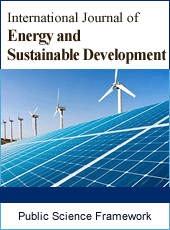International Journal of Energy and Sustainable Development
Articles Information
International Journal of Energy and Sustainable Development, Vol.3, No.4, Dec. 2018, Pub. Date: Jan. 19, 2019
Climate Change Induced Migration: Empirical Evidences from the Southwest Coastal Region of Bangladesh
Pages: 116-126 Views: 2871 Downloads: 636
[01]
Imtiaz Ahmad, Department of Urban and Rural Planning Discipline, Khulna University, Khulna, Bangladesh.
[02]
Sajadul Alam, Department of Environmental Science & Management, North South University, Dhaka, Bangladesh.
[03]
Abdun Naqib Jimmy, Department of Environmental Science & Management, North South University, Dhaka, Bangladesh.
[04]
Kaniz Fatema, Department of Urban and Rural Planning Discipline, Khulna University, Khulna, Bangladesh.
[05]
Md. Tariqul Islam, Department of Environmental Science & Management, North South University, Dhaka, Bangladesh.
[06]
Gias Uddin Ahsan, School of Health & Life Sciences, North South University, Dhaka, Bangladesh.
[07]
Nazmul Ahsan Khan, Department of Environmental Science & Management, North South University, Dhaka, Bangladesh.
Over the last few decades Bangladesh has already experienced the emergence of recurrent floods, severe cyclones, water logging, salinity intrusions, and riverbank erosion as the climatic push factors that have forced highly exposed and vulnerable coastal communities to migrate especially from the southwestern zone. However, only few ground level efforts have been made so far to scientifically explore and synthesize the general socio-demographic drivers, especially in terms of slow-onset disasters. So, this paper aims to explore various socio-demographic factors that influence migration decision making, and coherent dynamics of migration decision making in the context of both observed and anticipatory risk to the impacts of climate variability. The required primary data was collected through administering semi-structured questionnaire among 120 randomly selected households of Mollarhat and Monglaupazilas of Bagerhat district, from the southwest coastal zone of Bangladesh due to its immense vulnerability to cyclone and salinity intrusion. The findings of the study showed that majority of the respondents are well concerned about climate change and taking various measures to overcome its impacts. Perceived to be having an increasing trend, the study found a significant relationship between the migration trend in the localities and hazard years (e.g. cyclones, low rainfall etc.) and seasons (e.g. excessive rainfall). Although the primary motivation is better income for migrants or intended migrants, in effect, it acted as an effective form of adaptation during times of climatic stress. Seasonal migration was found to be a common trend, where the remittance sent by the migrants played roles as a means of income security when regular employment in their local area was not available due to various climatic stresses. Although most of the seasonal migration occurred to nearby regional destinations, a considerable portion of it was also found to be occurring at distant locations across the country. So, a major part of the migration was found to have occurred during the month of April to July and November to urban, sub-urban and even other villages for job. The study also identified that migration decision making due to climatic and non-climatic factors can often vary in terms of age, sex, occupational, educational, income and various vulnerability features.
Climate Change, Migration, Salinity, Adaptation
[01]
Steiner, A., 2008. Forced Migration. In: Human Security Policy Challenges. M. Couldrey, and M. Herson (eds.), Refugee Studies Centre, University of Oxford.
[02]
Stern, N., 2006. The Stern Review on the Economics of Climate Change. University Press.
[03]
Intergovernmental Panel for Climate Change (IPCC), 2007. Climate Change 2007: Impacts, Adaptation and Vulnerability. Cambridge University Press.
[04]
Piguet, E., 2011. The Migration/Climate Change Nexus: An Assessment, International conference on Rethinking Migration: Climate, Resource Conflicts and Migration in Europe, Berlin 13 -14 Oct. URL http://www.network-migration.org/rethinking-migration-2011/2/papers/Piguet.pdf, explored on October 30, 2012.
[05]
Bangladesh Bureau of Statistics (BBS), 2011, National Population and Housing Census, GoB, Dhaka.
[06]
Falguni, A., 2009. “Aila after Sidr”, The Daily Star, June 01.
[07]
Hossain, R., 2009. Climate Change Environmental Forced Migrants and Rural-Urban Migration: Are Big Cities Prepared in Bangladesh. Urban Poverty and Climate Change—Infrastructures of Development, Dhaka, pp. 163-170.
[08]
Siddiqui, T., 2011. “Climate Change Induced Displacement: Migration as an Adaptation Strategy”, The Daily Star, November 15.
[09]
McAdam, J., and Saul, B., 2010. Displacement with Dignity: International Law and Policy Responses to Climate Change Migration and Security in Bangladesh, University of New South Wales.
[10]
Ministry of Environment and Forest (MoEF), 2005. National Adaptation Program of Action, GoB, Dhaka.
[11]
Usgs.gov. (2018). USGS.gov | Science for a changing world. [online] Available at: https://www.usgs.gov/ [Accessed 30 Oct. 2016].

ISSN Print: Pending
ISSN Online: Pending
Current Issue:
Vol. 4, Issue 2, June Submit a Manuscript Join Editorial Board Join Reviewer Team
ISSN Online: Pending
Current Issue:
Vol. 4, Issue 2, June Submit a Manuscript Join Editorial Board Join Reviewer Team
| About This Journal |
| All Issues |
| Open Access |
| Indexing |
| Payment Information |
| Author Guidelines |
| Review Process |
| Publication Ethics |
| Editorial Board |
| Peer Reviewers |


